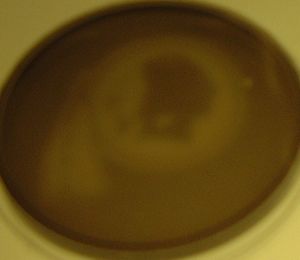2020(S11) Lecture:week 3: Difference between revisions
No edit summary |
No edit summary |
||
| Line 2: | Line 2: | ||
<div style="padding: 10px; width: 670px; border: 5px solid #CC9999;"> | <div style="padding: 10px; width: 670px; border: 5px solid #CC9999;"> | ||
=<center>Week 3 Tuesday </center>= | =<center>Week 3 Tuesday </center>= | ||
==<font color = blue> | ==<font color = blue>coliRoids </font color>== | ||
===Bacteria as pixels=== | ===Bacteria as pixels=== | ||
''E. coli'' do not normally respond to light but [http://www.nature.com/nature/journal/v438/n7067/full/nature04405.html a recent publication ] describes a combination of genes that lead to light-responsive expression of β-galactosidase in ''E. coli.'' Recall from your study of the lac operon in biology classes that β-galactosidase is an enzyme encoded by the LacZ gene. Normally the protein cleaves the disaccharide, lactose, into two monosaccharides, galactose and glucose. | ''E. coli'' do not normally respond to light but [http://www.nature.com/nature/journal/v438/n7067/full/nature04405.html a recent publication ] describes a combination of genes that lead to light-responsive expression of β-galactosidase in ''E. coli.'' Recall from your study of the lac operon in biology classes that β-galactosidase is an enzyme encoded by the LacZ gene. Normally the protein cleaves the disaccharide, lactose, into two monosaccharides, galactose and glucose. | ||
| Line 11: | Line 11: | ||
[[Image:Redskins.jpg|thumb|right| "coli-roid" example]] | [[Image:Redskins.jpg|thumb|right| "coli-roid" example]] | ||
For today, you can get | For today, you can get used to this system. You’ll plate a layer of cells on indicator medium, and then incubate the dish with a mask until next time. You and a partner can pick any image you'd like to develop. You expect the dark-grown plate to turn a dark color and the light-grown plate to stay light. | ||
==< | {| cellspacing="2" | ||
|- valign="top" | |||
|width="670px" class="MainPageBG" style="border: 1px solid #336600; color: #000; background-color: #FFFFFF"| | |||
<div style="padding: .4em .9em .9em"> | |||
<center>'''Why are we doing this??'''</center> | |||
The bacterial photography system was one of the very first successes from the iGEM summer competition. It provides an instance proof that a small group of motivated undergraduates and some clever advisers can engineering biology to do their bidding. The project also highlights how an understanding of basic biology (e.g. the lac operon and two component signaling) can lead to new applications when refined and improved. | |||
</div> | |||
|} | |||
=<center>Week 3 Studio</center>= | =<center>Week 3 Studio</center>= | ||
[[Image:BioPrimer6 title bactphoto.png|thumb|left|400px| [[Media:BioPrimer 6.jpg| BioPrimer6: Picture this!]] ]] | |||
==<font color = blue> '''Homework'''</font color>== | ==<font color = blue> '''Homework'''</font color>== | ||
=<center>Week 3 Thursday</center>= | =<center>Week 3 Thursday</center>= | ||
Revision as of 09:58, 31 January 2011
Week 3 Tuesday
coliRoids
Bacteria as pixels
E. coli do not normally respond to light but a recent publication describes a combination of genes that lead to light-responsive expression of β-galactosidase in E. coli. Recall from your study of the lac operon in biology classes that β-galactosidase is an enzyme encoded by the LacZ gene. Normally the protein cleaves the disaccharide, lactose, into two monosaccharides, galactose and glucose.
For the bacterial photography system, the "coliroid" cells producing LacZ cleave an indicator compound, giving rise to a black precipitate. When the cells are grown in the dark, transcription of LacZ is high and the indicator in the media turns black. When the cells are grown in the light, there is very little transcription of the LacZ gene and the media’s natural color (yellowish) shows through.


For today, you can get used to this system. You’ll plate a layer of cells on indicator medium, and then incubate the dish with a mask until next time. You and a partner can pick any image you'd like to develop. You expect the dark-grown plate to turn a dark color and the light-grown plate to stay light.
|
The bacterial photography system was one of the very first successes from the iGEM summer competition. It provides an instance proof that a small group of motivated undergraduates and some clever advisers can engineering biology to do their bidding. The project also highlights how an understanding of basic biology (e.g. the lac operon and two component signaling) can lead to new applications when refined and improved. |
Week 3 Studio

Homework
Week 3 Thursday
Getting to 3 ideas
We will not meet as a class today but you are expected to spend the 1.5 hours that you might have enjoyed in 26-152 looking at the requirements for the upcoming 3-Ideas Presentations and planning a project for which you can articulate at least 3 of these 5 points:
- What: what problem or opportunity are you thinking of focusing on? How sweeping or focused is this idea?
- How: what approach could you take to make a dent in the problem?
- What if if your project is fully successful, how big a difference could it make? what concerns does it raise?
- What else are there other technologies that can be used/have been used to address this area?
- Dunno how big are the gaps in what you know? how much is completely unknown or unknowable?
